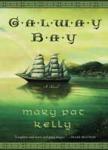Restringing the Harp
Perhaps the stellar Shakespeare mis-emphasized a bit when writing, “A sad tale’s best for winter.” For there are other tales—like the novel Galway Bay, for instance—that range from the joyous and funny through the sad and on to the bittersweet, but are also meant to be read over a couple of long winter evenings in a comfy chair with a high foot rest, alongside a cup of tea or hot toddy ready at hand.
Setting aside a few winter evenings is necessary because Galway Bay is both a family saga and a historical epic, replete with much romance and rigor, spanning the years 1839 to 1893 in both Ireland and America. In a novel that is Irish both in sensibility and circumstance, not unexpectedly the Catholic faith provides buoyant ballast in adversity; the humor throughout is by turns gentle or sardonic; the characters exhibit a toughness both resolute and wily, their confidence placed in pluck, not in luck.
The family’s saga is narrated by Honora Kelly (neé Keeley), whom we first meet in 1839 as a virginal 17-year-old preparing to enter the Sisters of the Presentation community three months hence, when, as in a Celtic legend, a handsome stranger suddenly emerges from the waters of Galway Bay and wins her heart immediately. Their branch of the Keeley-Kelly trees takes bud soon after.
As in all family histories, the characters are humanly universal and yet diverse individuals, as is the succession of events in their lives: first love, marriage, childbirths, first home, success and contentment, followed by horrific intrusions: the Great Famine of 1845-8, the shocking deaths of family and friends, the desperate voyage to “Amerikay,” arrival in an unwelcoming Chicago, the American Civil War, the Irish Fenians’ raid on Canada, and ending at the Chicago World’s Fair and a visit to its ersatz Irish village exhibit, providing an ironic looping to their story. Throughout, these public events coincide in memory with the dates of those in the Catholic Church’s calendar of feast days—Christmas especially but also Epiphany, the midsummer night of John the Baptist and others—thereby dramatically joining the Catholic sense of time passing with a family’s own rituals and experience.
Interwoven with the “real” history of the Kellys is the history of bitter Irish memories (the invasions of Cromwell and William of Orange, the Protestant Plantation), complemented by the recalling of happier Celtic myths of ancient warriors in all their ferocious glory. But such stories of broader public scale remain subordinate to the countless stories the novel’s characters tell each other by way of pointed example or moral fable. (Whenever a character begins with “Fádo”—Irish for “once upon a time”—the audience grows hushed and expectant, as does the reader.) One is reminded of the old woman from Cork who, when asked if she believed in fairies, replied tartly, “Of course not. But they’re there.”—itself a mini-story illustration of the Irish tilt toward skepticism and credulity simultaneously.
For Mary Pat Kelly, Galway Bay represents the capstone of an already distinguished career. She is a former screenwriter at Columbia and Paramount Pictures and associate producer at “Good Morning America” and “Saturday Night Live,” and has written five non-fiction books (two on the filmmaker Martin Scorsese) and one semi-autobiographical novel, Special Intentions. In an afterword, she reveals that, though fiction, this novel is the result of 35 years of research in both Ireland and the United States and, more specifically, research into her own family’s history, especially the recorded recollections of her great-great-grandmother, the original Honora Kelly.
In dire times, the Irish would encourage each other to hope for Ireland’s restoration by saying, “the Harp will be re-strung.” Mary Pat Kelly has done precisely that.
This article also appeared in print, under the headline “Restringing the Harp,” in the February 23, 2009, issue.








